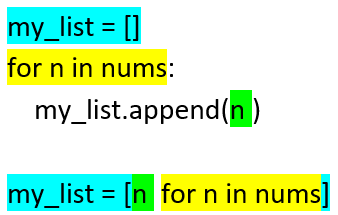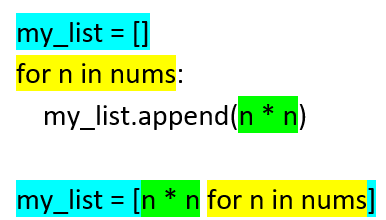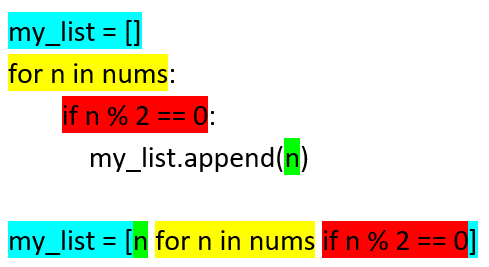1. List Comprehensions
See docs at: https://docs.python.org/3/tutorial/datastructures.html#list-comprehensions See ref video at: https://www.youtube.com/watch?v=3dt4OGnU5sM
1.1. List comprehension
Syntax:
- new_list = [expression for item in iterable]
- Parameters:
expression – the item variable only (e.g. x) or any expression such as one that uses the item variable (e.g. x * x).
item – a variable.
iterable – iterable objects like strings, lists, dictionaries, range function and others.
The first 2 examples illustrate simple list comprehensions without doing anything with the values.
1.1.1. List Example: list
nums = [1, 3, 6, 10, 15, 21, 28]
# I want 'n' for each 'n' in nums
my_list = []
for n in nums:
my_list.append(n)
print(my_list)
my_list_comprehension = [n for n in nums], does this in one line.nums = [1, 3, 6, 10, 15, 21, 28]
my_list_comprehension = [n for n in nums]
print(my_list_comprehension)

1.1.2. List Example: range
# I want 'n' for each 'n' from 1 to 10
my_list = []
for n in range(1, 11):
my_list.append(n)
print(my_list)
my_list_comprehension = [n for n in range(1, 11)], does this in one line.my_list_comprehension = [n for n in range(1, 11)]
print(my_list_comprehension)
1.1.3. List Example: n * n
nums = [1, 3, 6, 10, 15, 21, 28]
# I want 'n*n' for each 'n' in nums
my_list = []
for n in nums:
my_list.append(n * n)
print(my_list)
my_list_comprehension = [n * n for n in nums], does this in one line.nums = [1, 3, 6, 10, 15, 21, 28]
my_list_comprehension = [n * n for n in nums]
print(my_list_comprehension)

1.1.4. Practice Questions
Tasks
Use a list comprehension to create a list of 2 * n for each n in [0, 1, 1, 2, 3, 5, 8].
Use a list comprehension to create a list of 2 * n - 1 for each n in [2, 4, 6, 8, 10].
Use a list comprehension to create a list of n ** 3 for each n in [1, 2, 3, 4].
1.2. List comprehension: conditions
Syntax:
- new_list = [expression for item in iterable if condition == True]
- Parameters:
expression – the item variable only (e.g. x) or any expression such as one that uses the item variable (e.g. x*x, x.upper()).
item – variable.
iterable – iterable objects like strings, lists, dictionaries, range function and others.
condition – any condition.
1.2.1. List Example: Modulo
n % 2, returns 0 for even numbers.nums = [1, 3, 6, 10, 15, 21, 28]
# I want n for each n in nums if n is even
my_list = []
for n in nums:
if n % 2 == 0:
my_list.append(n)
print(my_list)
my_list_comprehension = [n for n in nums if n % 2 == 0], does this in one line.nums = [1, 3, 6, 10, 15, 21, 28]
# I want n for each n in nums if n is even
my_list_comprehension = [n for n in nums if n % 2 == 0]
print(my_list_comprehension)

1.2.2. Practice Questions
Tasks
Use a list comprehension to create a list of even n for each n in [1, 2, 3, 5, 8].
Use a list comprehension to create a list of odd n for each n in [1, 2, 3, 5, 8].
1.3. List comprehension: nested
Syntax:
- new_list = [expression for item1 in iterable1 for item2 in iterable2]
- Parameters:
expression – an expression using item1 and item2.
item2 – variable for iterable1.
iterable1 – iterable objects like strings, lists, dictionaries, range function and others.
item2 – variable for iterable2.
iterable2 – a second iterable objects like strings, lists, dictionaries, range function and others.
1.3.1. List Example: grid coordinates

# I want a (letter, num) pair for each letter in 'ABCD' and each number in '1234'
my_list = []
for letter in "ABCD":
for num in range(1, 5):
my_list.append((letter, num))
print(my_list)
my_list_comprehension = [(letter, num) for letter in "ABCD" for num in range(1, 5)]
print(my_list_comprehension)

1.3.2. Practice Questions
Tasks
Starting with two lists, [‘A’, ‘B’], [‘X’, ‘Y’], use a list comprehension to create the list: [(‘A’, ‘X’), (‘A’, ‘Y’), (‘B’, ‘X’), (‘B’, ‘Y’)].
Starting with two lists, [‘A’, ‘B’], [‘X’, ‘Y’], use a list comprehension to create the list: [‘AvX’, ‘AvY’, ‘BvX’, ‘BvY’].
1.3.3. Summary Examples
my_list_comprehension = [n for n in nums]
my_list_comprehension = [n for n in range(1, 11)]
my_list_comprehension = [n * n for n in nums]
my_list_comprehension = [n for n in nums if n % 2 == 0]
my_list_comprehension = [(letter, num) for letter in "ABCD" for num in range(1, 5)]
Set Comprehension on a List primes = [2, 2, 2, 3, 3, 5, 5, 5, 7, 11, 11, 13, 13, 13, 13] primes_squared = {p*p for p in primes} print(primes_squared)
More Complex Expressions: quadratic transformation Any expression is allowed. More complex expressions can be put in parentheses. Here, quadratic equation: 2x^2 + 5x + 10
transformed = {(2*x*x + 5*x + 10) for x in primes} print(transformed)
1.3.4. Making a 2D aray from a list
for i in range(0, len(nums), x), becomes for i in range(0, 6, 3) which has i values of 0 and 3.for j in range(i,i+x), becomes for j in range(0,3) when i is 0, and for j in range(3,6) when i is 3nums = [1, 3, 5, 7, 9, 11]
x = 3
list_2d = []
for i in range(0, len(nums), x):
rowlist = []
for j in range(i,i+x):
rowlist.append(nums[j])
list_2d.append(rowlist)
print(list_2d)
# [[1, 3, 5], [7, 9, 11]]
nums = [1, 3, 5, 7, 9, 11]
x = 3
list_2d = [nums[i:i+x] for i in range(0, len(nums), x)]
print(list_2d)
# [[1, 3, 5], [7, 9, 11]]